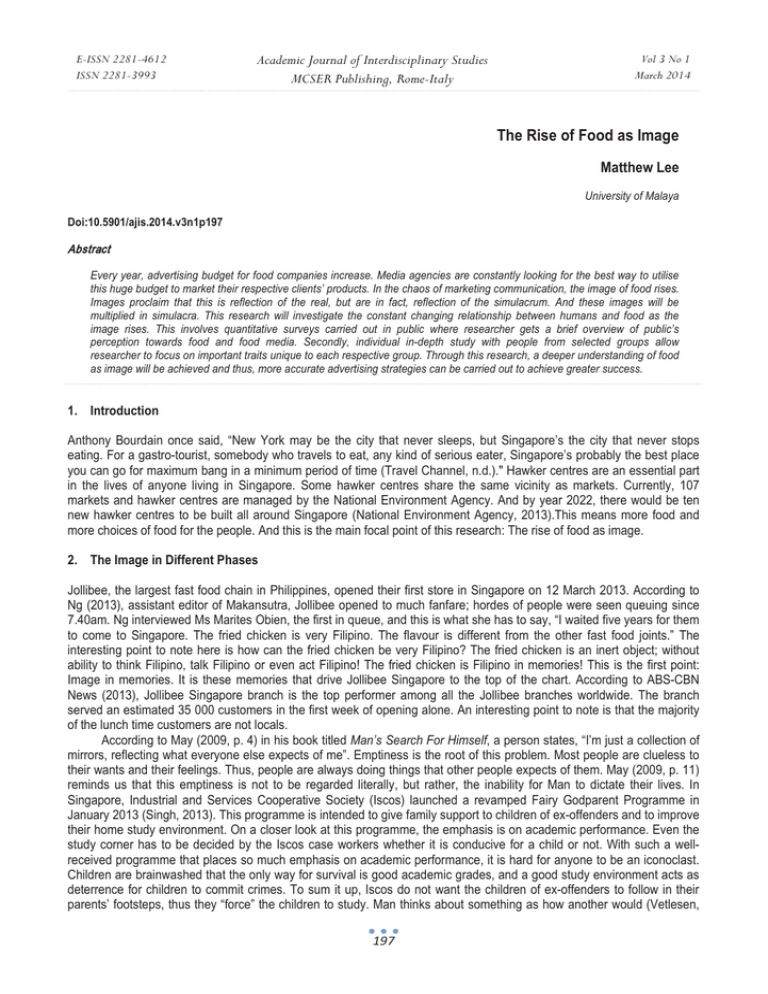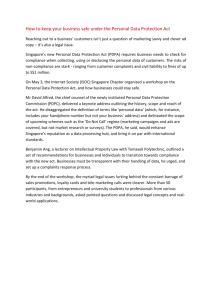The Rise of Food as Image Academic Journal of Interdisciplinary Studies
advertisement

E-ISSN 2281-4612 ISSN 2281-3993 Academic Journal of Interdisciplinary Studies MCSER Publishing, Rome-Italy Vol 3 No 1 March 2014 The Rise of Food as Image Matthew Lee University of Malaya Doi:10.5901/ajis.2014.v3n1p197 Abstract Every year, advertising budget for food companies increase. Media agencies are constantly looking for the best way to utilise this huge budget to market their respective clients’ products. In the chaos of marketing communication, the image of food rises. Images proclaim that this is reflection of the real, but are in fact, reflection of the simulacrum. And these images will be multiplied in simulacra. This research will investigate the constant changing relationship between humans and food as the image rises. This involves quantitative surveys carried out in public where researcher gets a brief overview of public’s perception towards food and food media. Secondly, individual in-depth study with people from selected groups allow researcher to focus on important traits unique to each respective group. Through this research, a deeper understanding of food as image will be achieved and thus, more accurate advertising strategies can be carried out to achieve greater success. 1. Introduction Anthony Bourdain once said, “New York may be the city that never sleeps, but Singapore’s the city that never stops eating. For a gastro-tourist, somebody who travels to eat, any kind of serious eater, Singapore’s probably the best place you can go for maximum bang in a minimum period of time (Travel Channel, n.d.)." Hawker centres are an essential part in the lives of anyone living in Singapore. Some hawker centres share the same vicinity as markets. Currently, 107 markets and hawker centres are managed by the National Environment Agency. And by year 2022, there would be ten new hawker centres to be built all around Singapore (National Environment Agency, 2013).This means more food and more choices of food for the people. And this is the main focal point of this research: The rise of food as image. 2. The Image in Different Phases Jollibee, the largest fast food chain in Philippines, opened their first store in Singapore on 12 March 2013. According to Ng (2013), assistant editor of Makansutra, Jollibee opened to much fanfare; hordes of people were seen queuing since 7.40am. Ng interviewed Ms Marites Obien, the first in queue, and this is what she has to say, “I waited five years for them to come to Singapore. The fried chicken is very Filipino. The flavour is different from the other fast food joints.” The interesting point to note here is how can the fried chicken be very Filipino? The fried chicken is an inert object; without ability to think Filipino, talk Filipino or even act Filipino! The fried chicken is Filipino in memories! This is the first point: Image in memories. It is these memories that drive Jollibee Singapore to the top of the chart. According to ABS-CBN News (2013), Jollibee Singapore branch is the top performer among all the Jollibee branches worldwide. The branch served an estimated 35 000 customers in the first week of opening alone. An interesting point to note is that the majority of the lunch time customers are not locals. According to May (2009, p. 4) in his book titled Man’s Search For Himself, a person states, “I’m just a collection of mirrors, reflecting what everyone else expects of me”. Emptiness is the root of this problem. Most people are clueless to their wants and their feelings. Thus, people are always doing things that other people expects of them. May (2009, p. 11) reminds us that this emptiness is not to be regarded literally, but rather, the inability for Man to dictate their lives. In Singapore, Industrial and Services Cooperative Society (Iscos) launched a revamped Fairy Godparent Programme in January 2013 (Singh, 2013). This programme is intended to give family support to children of ex-offenders and to improve their home study environment. On a closer look at this programme, the emphasis is on academic performance. Even the study corner has to be decided by the Iscos case workers whether it is conducive for a child or not. With such a wellreceived programme that places so much emphasis on academic performance, it is hard for anyone to be an iconoclast. Children are brainwashed that the only way for survival is good academic grades, and a good study environment acts as deterrence for children to commit crimes. To sum it up, Iscos do not want the children of ex-offenders to follow in their parents’ footsteps, thus they “force” the children to study. Man thinks about something as how another would (Vetlesen, 197 E-ISSN 2281-4612 ISSN 2281-3993 Academic Journal of Interdisciplinary Studies MCSER Publishing, Rome-Italy Vol 3 No 1 March 2014 2009, p. 59). Heidegger (1996, p. 111) in Being and Time, wrote about how Man is one with the world. Bearing this in mind, it is of no surprise that the Fairy Godparent Programme has won a lot of praises from the public. A society of mirrors! Or May (2009, p. 7) would proclaim the hollowness of people. And this is the second point: Image in projected future. Mirrors serve a purpose for reflecting. When looking at a mirror, Man is in control of what they like to see. Man can either change himself to suit the reflected image that he wishes to see, or change his perception on the image that he is seeing. How Man sees things, is always affected by knowledge or perception (Berger, 2008). After seeing, comes the process of looking. Looking involves a choice. When Man looks, a mental process of relating the object being looked at with himself is established. The substance of the image is determined by the viewer, and which is already in the viewer’s mind (Sartre, 1991). Berger (2008, p. 1) states that looking is never just on one thing, but instead we are constantly looking at the relationship of things and ourselves. In December 2011, clothing company H&M revealed that the models featured in its holiday season catalogue were virtual women, Rees (2011) of New York Magazine commented that it is strange that H&M would rather tweaked the bodies instead of the garment. This is clearly the point that Rees misses: The virtual models are intended to be far more attractive than the clothes themselves and that is precisely why companies engage attractive people to be their models for advertisements. Coming back to the point of relation with objects, this is the whole idea when people relate themselves to the beauty of the model with the clothes that is worn. And often times in Asia, women would try on the exact clothes and disappointedly proclaim that the clothes look better on the model! Thus, women would mimic the model: Dyeing hair blonde, breast enlargement, skin bleaching, etc... In Thailand, an innovative way of breast enlargement known as breast slapping which has been in the market for around two decades (CNN Travel, 2011). The Thai government has endorsed this technique and even sponsored a programme that showed women learning to slap their own breasts (Dumas, 2011). What then is the actual image? According to Peirce (1931-58, 2.302), all our thoughts are based on signs. Things become signs when meaning is placed in them. Thus, everything that passes through the senses, interpreted by the human brain, becomes a sign. Things get interpreted as signs before Man even acknowledges the signs because of the familiarity of categorisation of things (Chandler, 2006). So what is a sign? Saussure (1983, p. 66) stated that signs are made up of ‘signifier’ and ‘signified’. He discussed ‘signifier’ as how sound is interpreted by our psyche. But he noted that it could be materialistic too, as long as it represents the impressions that come about by senses. ‘Signified’ is just the concept. In the present day, the ‘Saussurean’ model is interpreted in a more materialistic way (Chandler, 2006, p. 18). The ‘signifier’ is the material (or physical) form of the sign. To sum it up, a sign has to have a signifier with meaning and a signified with form (Saussure, 1983, p. 101). Bearing in mind that a particular signifier could mean a variety of signifieds in different situations, and vice versa (Chandler, 2006, p. 19). And example is this Burger King print advertisement (Figure 1) that was released in Sweden in 2012 (Burger King “Bags” print ad, n.d.): Figure 1: An advertisement like this draws a variety of ‘signifieds’ and ‘signifiers’. Focusing on the luggage and bags, it can either be concluded they are on sale or given by Burger King, or they are trying to imply that a set meal could be taken away. In this manner, the luggage and bags do not “exist” practically, but just as a metaphor for the concept of take away. Thus, coming back to the question of what is the actual image, researcher believes that the actual image only exists when we do not see it. The very fact that when we see it, it will go to the next stage of looking, and information goes through our brain and “distorts” the actuality. 198 E-ISSN 2281-4612 ISSN 2281-3993 Academic Journal of Interdisciplinary Studies MCSER Publishing, Rome-Italy Vol 3 No 1 March 2014 3. The Study 3.1 Quantitative For this quantitative study, 140 selected respondents were chosen for the quantitative study to determine the power of influence of the actual food versus the image. There were 20 respondents for each of the seven age groups (yrs): 13-16, 17-20, 21-25, 26-32, 33-45, 46-60 and >60. There were equal numbers of males and females for each age group. Respondents were each given a short questionnaire that requires them to place a tick in the respective boxes. A copy of the questionnaire is (Figure 2): Figure 2: 3.2 Qualitative For this qualitative study, 8 respondents volunteered to be monitored for a week. There were 2 respondents for each of the four age groups (yrs): 13-20, 21-32, 33-60 and >60. Each age group consisted of a male and a female. Respondents were given the task of noting down what they would like to eat before meal time. They were advised not to see any pictures of their intended meals. Upon arrival at their intended destination for meals, they were instructed to look at pictures of their intended meals. If no pictures were available, then they would have to look at pictures of meals similar to the ones they intended to have. If they still ordered the same meal as what they initially had in mind, they would have to place a tick under the category Predisposed thought and Image. If they chose not to order the meal that they initially had in mind, prior to seeing the pictures, then they would have to place a tick under the category Image only. Respondents 199 Academic Journal of Interdisciplinary Studies MCSER Publishing, Rome-Italy E-ISSN 2281-4612 ISSN 2281-3993 began this study on the same date and did this everyday for a week. A copy of the study plan is (Figure 3): Figure 3: 4. The Results 4.1 Quantitative Age Group (yrs) 13 – 16 17 – 20 21 – 25 26 – 32 33 – 45 46 – 60 > 60 Influenced by Food ( 60%) ƕ ƕ ƕ ƕ 200 Influenced by Food Image ( 60%) ƕ ƕ ƕ ƕ ƕ ƕ Vol 3 No 1 March 2014 E-ISSN 2281-4612 ISSN 2281-3993 Academic Journal of Interdisciplinary Studies MCSER Publishing, Rome-Italy Vol 3 No 1 March 2014 For the three age groups between the ages of 13-25, results were consistent. More than or equal to 60% agreed that their decision to order any food is influenced by the image of it. For the next three age groups between the ages of 26-60, results were consistent too. More than or equal to 60% were influenced by the food as well as the image of it. For those above 60 years of age, they were only influenced by the food itself. 4.2 Qualitative Age Group 13 - 20 21 - 32 33 - 60 > 60 Food (Predisposed thought) ( 60%) ƃ ƃ ƃƂ Food (Image) ( 60%) ƃƂ Ƃ Ƃ From the results, researcher could open up more perimeters for discussion, but that would distract the reader from the main topic of this research. The extremity of viewpoints are crucial in this research, and researcher would want to focus on this extreme which is the category Food (Image). For the 13-20 age group, both the male and female were more influenced by the image. For the next two age groups between the ages of 21-60, only females were more influenced by the image. And for the last age group, food imagery was not powerful enough to change their predisposed thoughts. 5. Conclusion From the results of the quantitative and qualitative study, researcher can conclude that the more influenced people are by images, the more it can change peoples’ predisposed thoughts. But from the results, another factor has to be factored in is age. Maybe age plays a part in how influential images are? Based on the results, the younger group are more susceptible to the power of the image, as compared to the older ones. But due to the time and financial constraints in this research, researcher could not open up more perimeters for discussion. In the liquid modern society, actions and results do not always move in tandem. Everything in this world loses their worth in due time due to consumption patterns (Bauman, 2007). Media and images lose their worth in this regard if they stagnate. Thus, in society today, images constantly take on new armour for a never ending war with the world. And reality of the actuality is replaced by the reality of the imagery. This is the rise of the food as image! When images are thought of as signs, countless signifieds are produced. Thus, how food is judged, is by their sign, or image. That is how food is consumed in the present day. References ABS-CBN News. (2013, April 7). Jollibee Singapore named no. 1 branch globally. Retrieved September 01, 2013, from http://www.abscbnnews.com/lifestyle/07/04/13/jollibee-singapore-named-no-1-branch-globally Bauman, Z. (2007). Liquid life. Great Britan: Polity Press. Berger, J. (2008). Ways of seeing. Great Britain: Penguin Group. Burger King “Bags” print ad. (n.d.). Retrieved October 01, 2013, from Coloribus website, http://www.coloribus.com/adsarchive/prints/burger-king-bags-15414905/ Chandler, D. (2006). Semiotics. New York: Routledge. CNN Travel. (2011, September). Ladies: Come to Thailand and get your breasts slapped. Retrieved September 13, 2013, from the CNN website: http://travel.cnn.com/bangkok/shop/ladies-come-thailand-and-get-your-boobs-smacked-809478 Dumas, D. (2011). Nothing like a bit of slap: Bizarre thai beauty treatment sees therapist hit breasts to make them larger [Electronic version]. Mail Online. Retrieved September 06, 2013, from http://www.dailymail.co.uk/femail/article-2039764/Thai-breastslapping-therapist-claims-hitting-boobs-makes-bigger.html#ixzz2lMGCqgIB Heidegger, M. (1996). Being and time. USA: State University of New York Press, Albany. May, R. (2009). Man’s search for himself. New York: W.W. Norton & Company, Inc. National Environment Agency. (2013). New hawker centres. Retrieved October 06, 2013, from http://app2.nea.gov.sg/home Ng, S. (2013, March), Large crowd welcomes Jollibee’s opening. Yahoo Entertainment. Retrieved September 01, 2013, from http://sg.entertainment.yahoo.com/news/large-crowd-welcomes-jollibee-opening-041155380.html Peirce, C. S. (1931-58). Collected writings (8 vols) (ed. Charles Hartshorne, Paul Weiss and Arthur W. Burks). Cambridge, MA: Harvard University Press. Rees, A. (2011, May. 12). H&M’s new lingerie models are computer-generated. New York Magazine. Retrieved September 07, 2013, from http://nymag.com/thecut/2011/12/hms-new-lingerie-models-are-computer-generated.html 201 E-ISSN 2281-4612 ISSN 2281-3993 Academic Journal of Interdisciplinary Studies MCSER Publishing, Rome-Italy Sartre, J. P. (1991). The psychology of imagination. New York: Citadel Press. Saussure, F. D. (1983). Course in general linguistics. London: Duckworth Singh, B. (2013, July 16). Tailor-made help for children of ex-offenders. The Straits Times, p. B1. Travel Channel. (n.d.). Anthony Bourdain's travel tips for Singapore. Retrieved http://www.travelchannel.com/interests/host-central/articles/tonys-singapore-tips Vetlesen, A. J. (2009). A philosophy of pain. London: Reaktion Books Ltd. 202 Vol 3 No 1 March 2014 October 05, 2013, from




